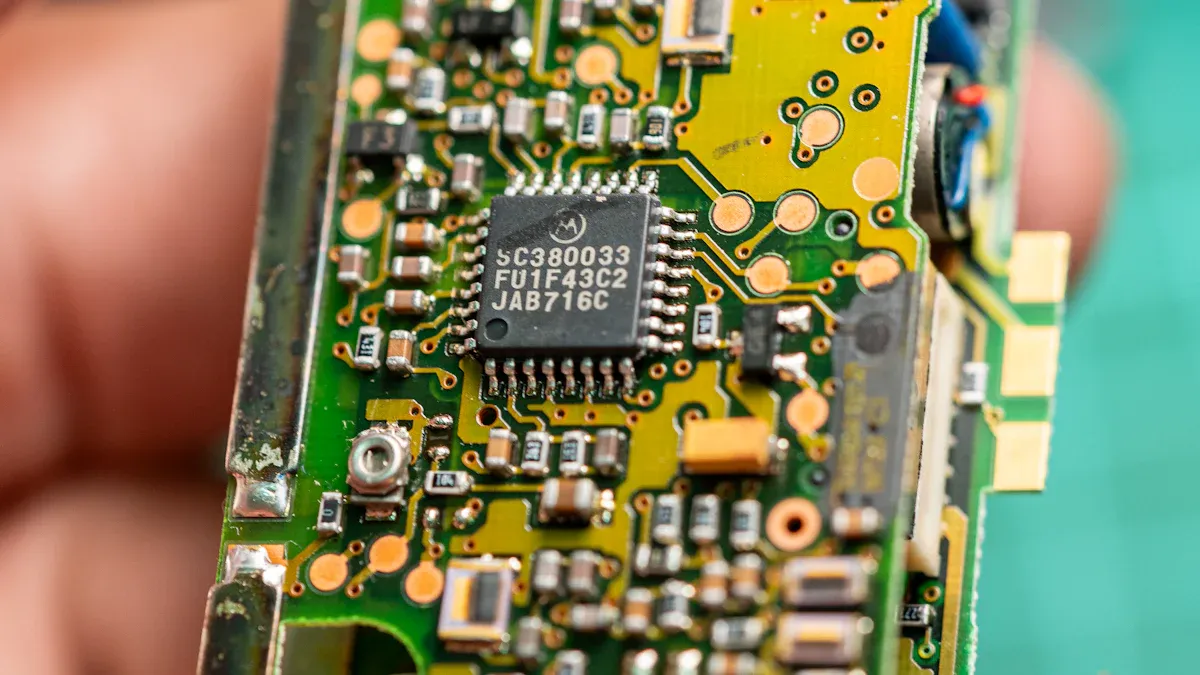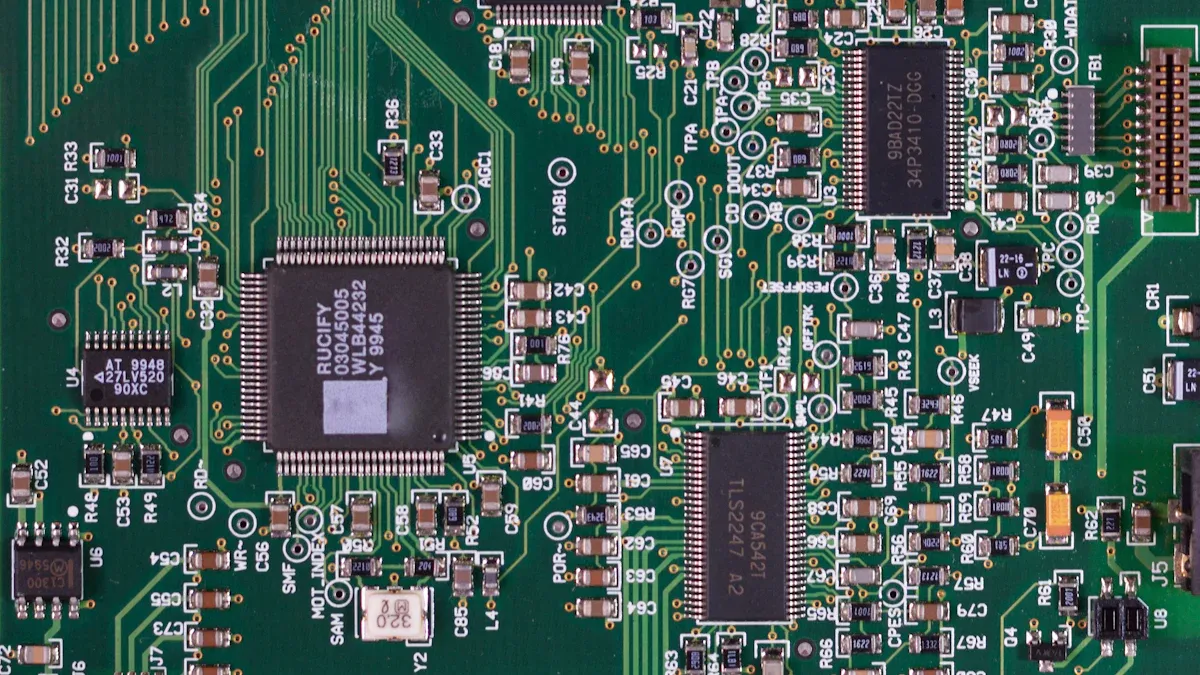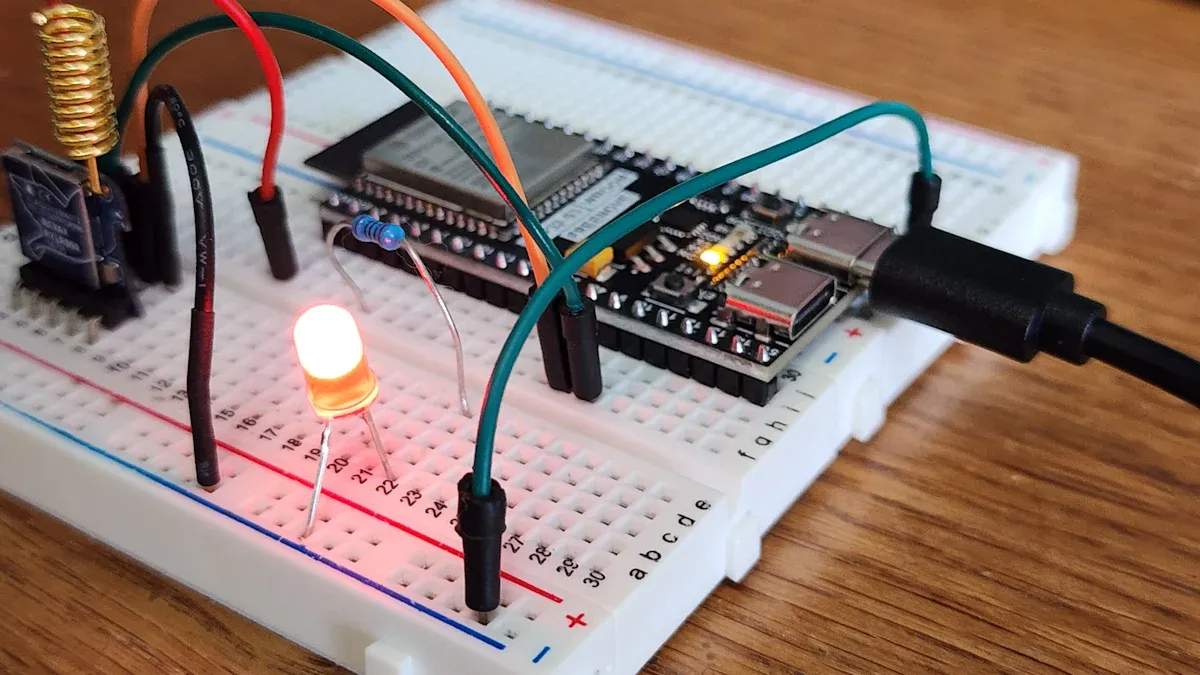What is an Amplifier Integrated Circuit and How Does It Work

An amplifier integrated circuit boosts weak electrical signals so you can hear music, talk on your phone, or use smart devices with clear sound. You find these circuits in almost every electronic device you use every day. The global market for amplifier integrated circuits continues to grow, reaching $4.13 billion in 2024, thanks to demand in cars, consumer electronics, and new technology like 5G and electric vehicles.
Key Takeaways
Amplifier integrated circuits boost weak electrical signals to make sounds clearer and devices work better.
These circuits use tiny parts like transistors, resistors, capacitors, and diodes to amplify and shape signals inside a small chip.
Operational amplifiers (op-amps) are key components that increase signal strength with precision and stability.
Proper power supply and impedance matching are essential for the amplifier to deliver clean, strong output without distortion.
Different types of amplifier ICs serve various needs, from high-quality audio to sensor accuracy and power delivery in many everyday devices.
Amplifier Integrated Circuit Basics

What It Is
You can think of an amplifier integrated circuit as a small electronic chip that boosts weak signals. This chip contains many tiny parts, like transistors and resistors, all packed together. You often find these circuits in devices that need to make sounds louder or signals stronger. For example, your phone, speakers, and even some toys use them. The amplifier integrated circuit takes up less space than using separate parts, so your devices can stay small and light.
Tip: When you see the word "IC," it usually means "integrated circuit," which is a chip that does a special job inside your device.
Main Function
The main job of an amplifier integrated circuit is to make weak electrical signals stronger. You need this function in many everyday electronics. Here are some common things these circuits do:
Amplify signals so you can hear music or voices clearly.
Help with timing and counting in digital clocks or timers.
Control voltage to keep your devices running safely.
Perform mathematical operations in calculators and computers.
Filter signals to remove unwanted noise.
You will often see operational amplifiers, or op-amps, used for these tasks. For example, the LM741 is a popular op-amp that helps with signal amplification and other functions. Analog ICs, like these, handle signals that change smoothly, such as music or voice. By using amplifier integrated circuits, you get devices that are smaller, more reliable, and able to do more than ever before.
Components
Internal Parts
When you look inside an amplifier integrated circuit, you find many tiny parts working together. These parts include both active and passive components. Each one has a special job to help the circuit boost signals and stay stable.
Transistors act as the main building blocks. They control and amplify the flow of electrical signals. Without transistors, the circuit could not make weak signals stronger.
Resistors help manage the amount of current that flows through the circuit. They keep the operation steady and protect other parts from too much current.
Capacitors store and release energy. They filter out unwanted noise and help shape the sound or signal you hear.
Diodes make sure current flows in only one direction. This protects the circuit and keeps signals moving the right way.
You also find special pins on the chip that connect to the outside world. Here is a table showing what each pin does:
Pin Number | Function Description |
|---|---|
1, 8 | Gain control pins used to adjust amplification level |
2 | Negative input pin (inverting input) |
3 | Positive input pin (non-inverting input) |
4 | Ground (GND) pin |
5 | Output pin delivering the amplified signal |
6 | Voltage supply pin providing power to the IC |
7 | Bypass pin used to reduce power supply noise |
All these parts work together inside the amplifier integrated circuit to give you clear, strong signals.
Operational Amplifiers
Operational amplifiers, or op-amps, play a key role in most amplifier integrated circuits. You use them to boost the difference between two input signals. Each op-amp has two main inputs: one inverting (marked with a minus sign) and one non-inverting (marked with a plus sign). The op-amp amplifies the voltage difference between these inputs.
Op-amps have high input impedance, so they do not draw much current from your signal source. They also have low output impedance, which means they can drive other parts of your device easily. You can set up op-amps in different ways, such as inverting, non-inverting, or as a voltage follower. Each setup gives you different types of amplification.
Note: Negative feedback is often used with op-amps. This technique helps control the gain and keeps the output stable, even if the internal parts change a little over time.
You find op-amps in many devices because they offer precise, stable, and flexible amplification. They help your amplifier integrated circuit handle everything from music signals to sensor data.
How an Amplifier Integrated Circuit Works

Signal Amplification
When you use an amplifier integrated circuit, it takes a weak signal and makes it much stronger. This process happens in several steps inside the chip. Here is how the signal amplification works:
The input signal first passes through coupling capacitors. These parts block unwanted DC signals and let only the AC part of your signal through.
A biasing network sets the right working point for the transistors or active devices. This step keeps the circuit stable and ready to amplify.
The small input signal changes the base current in a transistor or the voltage difference in an operational amplifier.
This change controls a much larger current or voltage in the next stage, which creates a bigger version of your original signal.
Sometimes, the circuit uses more than one amplification stage. Each stage boosts the signal even more.
Feedback systems help keep the gain steady, reduce distortion, and make sure the amplifier works well over a wide range of signals.
Modern amplifier integrated circuits include built-in bias circuits, temperature controls, and protection features. These extras help the chip work better and last longer.
You can find different ways to set up the amplifier inside the chip. Some common setups include:
Inverting amplifier: You connect the input to the inverting terminal. The output is stronger but flipped in phase.
Non-inverting amplifier: You connect the input to the non-inverting terminal. The output is stronger and matches the input phase.
Voltage follower: This setup gives a gain of 1. It is useful for matching impedance between parts of your circuit.
Differential amplifier: This type boosts the difference between two inputs and ignores noise that both inputs share.
Tip: High input impedance means the amplifier does not draw much current from your signal source. Low output impedance means it can drive other parts of your device easily.
Power Supply and Output
The power supply is a key part of how an amplifier integrated circuit works. You need a steady and clean power source to get the best performance. Here are the main types of power supplies you might use:
Linear power supplies give you a very stable voltage with almost no noise. These work best for sensitive circuits.
Switched-mode power supplies (SMPS) are more efficient but can add some noise to your circuit.
Mixed architecture power supplies combine both types to balance efficiency and low noise.
Low ripple and noise in your power supply are important. If the voltage changes too much, your amplifier may not work right or could add unwanted sounds to your signal.
The output of your amplifier integrated circuit depends on both the input signal and the power supply. The table below shows how different factors affect the output:
Aspect | Explanation |
|---|---|
Input Signal | The output is a stronger version of the input, scaled by the amplifier's gain. |
Gain | This is the ratio of output voltage to input voltage. It tells you how much the signal is amplified. |
Power Supply | Sets the limits for how much voltage and current the output can have. |
Output Saturation/Clipping | If the input is too strong or the power supply is too weak, the output signal gets cut off or distorted. |
Output Impedance | Affects how well the amplifier can drive the next part of your circuit. |
Load Impedance | Needs to match the amplifier so you do not overload it and get the best power transfer. |
Biasing and Design | Internal settings and design choices affect how the input turns into the output. |
Heat Dissipation | The amplifier makes heat as it works. Good heat management keeps it running well and lasting longer. |
Note: The output voltage is always limited by the power supply. If you try to get more output than the supply allows, the signal will clip or distort.
You can see that the amplifier integrated circuit gives you a clean, strong output only when you match the input, power supply, and load correctly. This careful balance helps your devices work smoothly and reliably.
Key Features
Gain
Gain tells you how much an amplifier integrated circuit increases the strength of a signal. You measure gain as the ratio of output voltage to input voltage, usually in decibels (dB). For example, if you put in a small signal and get a much larger one out, the amplifier has high gain. Most commercial amplifier ICs have gain values between 26 dB and 32 dB. Some special designs, like the FatKeys™ SSI2162, can adjust gain from +20 dB down to –100 dB. This wide range lets you control noise and dynamic range for different needs. Audio amplifiers often use a gain of about 29 dB, which balances loudness and sound quality. When you look at datasheets, you may see gain listed at different frequencies. Gain can change as the frequency of the signal changes, so engineers use graphs to show this relationship.
Tip: Higher gain can make signals louder, but it can also increase noise and distortion. You want to pick the right gain for your application.
Impedance
Impedance is like resistance, but it works for both AC and DC signals. You find two main types in amplifier ICs: input impedance and output impedance. Input impedance tells you how much the amplifier resists incoming signals. Output impedance shows how well the amplifier can drive the next part of your circuit. Most amplifier ICs have high input impedance, often from thousands (kilo-ohms) to millions (mega-ohms) of ohms. Output impedance is usually low, often just a few hundred ohms. This setup helps your amplifier accept weak signals without loading them down and send strong signals to speakers or other devices.
Parameter | Typical Values | Notes |
|---|---|---|
Input Impedance | Higher values mean less loading on the signal source. | |
Output Impedance | Hundreds of ohms (e.g., 833 Ω) | Lower values help drive loads like speakers or headphones. |
Proper impedance matching helps you get the best sound and signal quality. If you match the input and output impedances well, you avoid signal loss and distortion.
Common Mode Rejection
Common Mode Rejection Ratio (CMRR) tells you how well an amplifier ignores unwanted signals that appear on both inputs at the same time. You want a high CMRR so your amplifier can focus on the real signal and block out noise, like interference from power lines or other electronics. High-performance amplifier ICs often have CMRR values from 70 dB to 120 dB. This means they can reject most unwanted noise and keep your signal clean. Engineers use special resistor matching and design tricks to reach these high values.
Note: A high CMRR is very important in audio, sensor, and communication systems. It helps you get accurate results, even in noisy environments.
Types and Applications
Main Types
You can find several main types of amplifier integrated circuits, each designed for a specific job. Here are the most common categories:
Class A Amplifiers: These give you the best sound quality with very low distortion. They use more power and often run hot, so you see them in high-end audio systems.
Class B Amplifiers: These work more efficiently but can add some distortion, so you usually find them in budget audio setups.
Class AB Amplifiers: These combine the good parts of Class A and B. They balance sound quality and efficiency, making them popular in home theaters and car audio systems.
Class D Amplifiers: These use digital technology to save power and space. You often see them in portable speakers, headphones, and battery-powered devices.
Other Classes (G, H): These use special tricks to save even more power, especially in professional audio gear.
You also have different amplifier integrated circuits based on their job:
Amplifier Type | Design Focus and Characteristics | Typical Applications |
|---|---|---|
High accuracy, rejects noise, needs few extra parts, works well with tiny signals. | Medical monitors, industrial sensors, lab equipment | |
Audio Amplifier | Focuses on sound quality and low noise. | Speakers, headphones, home theaters |
Power Amplifier | Delivers lots of power to big loads, like motors or speakers. | Car audio, power supplies, industrial machines |
Tip: Instrumentation amplifiers help you measure very small signals, even in noisy places. Audio amplifiers make your music sound clear. Power amplifiers give enough energy to drive big devices.
Everyday Uses
You use amplifier integrated circuits in many devices every day. Here are some examples:
Audio Systems: Home theaters, car stereos, headphones, and portable speakers all use these chips to make sound louder and clearer. Class AB and Class D amplifiers are common here because they balance sound quality and efficiency.
Communication Devices: Smartphones and radios need to boost weak signals so you can hear calls and music clearly. These chips also help filter and process signals for better voice and data quality. In wireless devices, special amplifiers handle high-frequency signals for 4G, 5G, and Wi-Fi.
Industrial Machines: Factories use amplifier integrated circuits to read signals from sensors and control machines. Instrumentation amplifiers keep signals accurate, even with lots of electrical noise around. They also help protect equipment and people by isolating high voltages.
Using the right amplifier integrated circuit helps your devices work better, sound clearer, and stay safe—even in tough environments.
You rely on amplifier ICs every day. These chips use transistors and other parts to boost signals, making your devices smaller, lighter, and more efficient.
They help you hear music, talk on phones, and use smart gadgets.
Their design supports miniaturization and energy savings in electronics.
If you want to learn more, check out open textbooks or hands-on projects about operational amplifiers. Exploring these resources can help you understand how these tiny chips power modern technology.
FAQ
What is the main job of an amplifier integrated circuit?
You use an amplifier integrated circuit to make weak electrical signals stronger. This helps your devices produce clear sound, send data, or read sensor signals.
Can you use amplifier ICs in battery-powered devices?
Yes, you can. Many amplifier ICs use very little power. You find them in portable speakers, hearing aids, and smartphones.
How do you know if an amplifier IC is working?
You can check the output signal. If the sound or signal is louder and clear, the IC works. If you hear noise or nothing at all, the IC may have a problem.
Why do amplifier ICs get hot?
Amplifier ICs create heat when they boost signals. If you use high power or play loud sounds, the chip works harder and gets warmer. Good ventilation helps keep it cool.
What happens if you connect the wrong power supply?
Using the wrong power supply can damage the amplifier IC. You might hear distortion, or the chip could stop working. Always check the voltage and current before you connect power.
See Also
Exploring Isolation Amplifier ICs And Their Practical Applications
How Fully Integrated Processors Function And Their Benefits
Understanding Integrated Battery Monitor ICs And Their Operation
The Importance Of Integrated Circuits In Today’s Electronics
